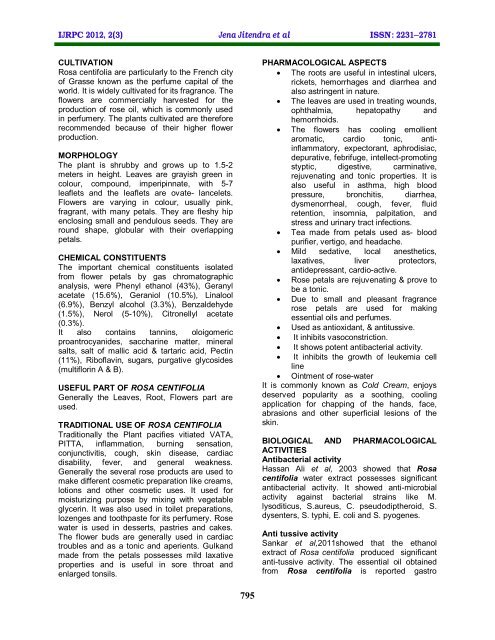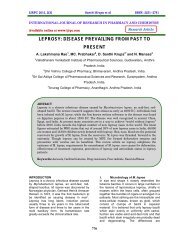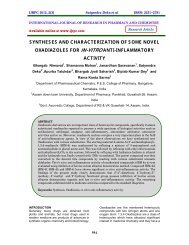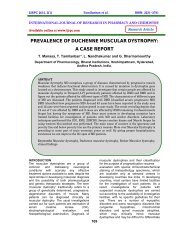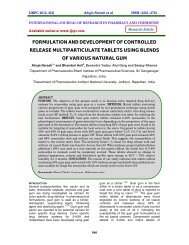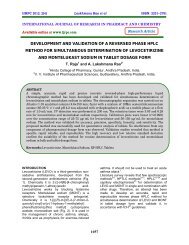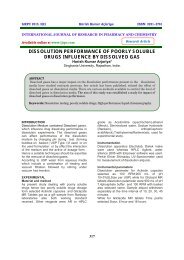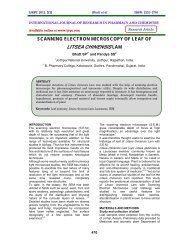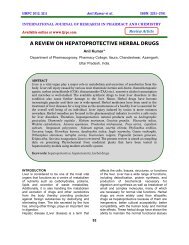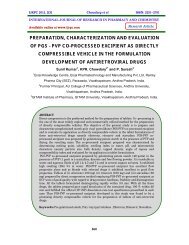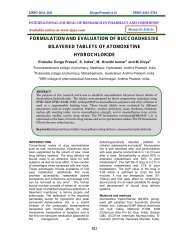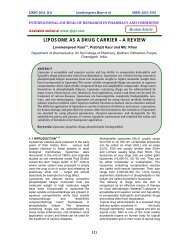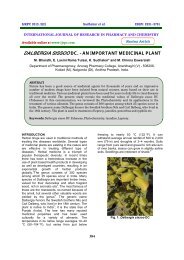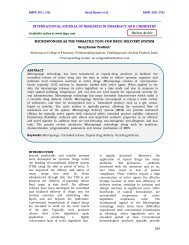ROSA CENTIFOLIA: PLANT REVIEW - ijrpc
ROSA CENTIFOLIA: PLANT REVIEW - ijrpc
ROSA CENTIFOLIA: PLANT REVIEW - ijrpc
You also want an ePaper? Increase the reach of your titles
YUMPU automatically turns print PDFs into web optimized ePapers that Google loves.
IJRPC 2012, 2(3) Jena Jitendra et al ISSN: 2231�2781<br />
CULTIVATION<br />
Rosa centifolia are particularly to the French city<br />
of Grasse known as the perfume capital of the<br />
world. It is widely cultivated for its fragrance. The<br />
flowers are commercially harvested for the<br />
production of rose oil, which is commonly used<br />
in perfumery. The plants cultivated are therefore<br />
recommended because of their higher flower<br />
production.<br />
MORPHOLOGY<br />
The plant is shrubby and grows up to 1.5-2<br />
meters in height. Leaves are grayish green in<br />
colour, compound, imperipinnate, with 5-7<br />
leaflets and the leaflets are ovate- lancelets.<br />
Flowers are varying in colour, usually pink,<br />
fragrant, with many petals. They are fleshy hip<br />
enclosing small and pendulous seeds. They are<br />
round shape, globular with their overlapping<br />
petals.<br />
CHEMICAL CONSTITUENTS<br />
The important chemical constituents isolated<br />
from flower petals by gas chromatographic<br />
analysis, were Phenyl ethanol (43%), Geranyl<br />
acetate (15.6%), Geraniol (10.5%), Linalool<br />
(6.9%), Benzyl alcohol (3.3%), Benzaldehyde<br />
(1.5%), Nerol (5-10%), Citronellyl acetate<br />
(0.3%).<br />
It also contains tannins, oloigomeric<br />
proantrocyanides, saccharine matter, mineral<br />
salts, salt of mallic acid & tartaric acid, Pectin<br />
(11%), Riboflavin, sugars, purgative glycosides<br />
(multiflorin A & B).<br />
USEFUL PART OF <strong>ROSA</strong> <strong>CENTIFOLIA</strong><br />
Generally the Leaves, Root, Flowers part are<br />
used.<br />
TRADITIONAL USE OF <strong>ROSA</strong> <strong>CENTIFOLIA</strong><br />
Traditionally the Plant pacifies vitiated VATA,<br />
PITTA, inflammation, burning sensation,<br />
conjunctivitis, cough, skin disease, cardiac<br />
disability, fever, and general weakness.<br />
Generally the several rose products are used to<br />
make different cosmetic preparation like creams,<br />
lotions and other cosmetic uses. It used for<br />
moisturizing purpose by mixing with vegetable<br />
glycerin. It was also used in toilet preparations,<br />
lozenges and toothpaste for its perfumery. Rose<br />
water is used in desserts, pastries and cakes.<br />
The flower buds are generally used in cardiac<br />
troubles and as a tonic and aperients. Gulkand<br />
made from the petals possesses mild laxative<br />
properties and is useful in sore throat and<br />
enlarged tonsils.<br />
795<br />
PHARMACOLOGICAL ASPECTS<br />
� The roots are useful in intestinal ulcers,<br />
rickets, hemorrhages and diarrhea and<br />
also astringent in nature.<br />
� The leaves are used in treating wounds,<br />
ophthalmia, hepatopathy and<br />
hemorrhoids.<br />
� The flowers has cooling emollient<br />
aromatic, cardio tonic, antiinflammatory,<br />
expectorant, aphrodisiac,<br />
depurative, febrifuge, intellect-promoting<br />
styptic, digestive, carminative,<br />
rejuvenating and tonic properties. It is<br />
also useful in asthma, high blood<br />
pressure, bronchitis, diarrhea,<br />
dysmenorrheal, cough, fever, fluid<br />
retention, insomnia, palpitation, and<br />
stress and urinary tract infections.<br />
� Tea made from petals used as- blood<br />
purifier, vertigo, and headache.<br />
� Mild sedative, local anesthetics,<br />
laxatives, liver protectors,<br />
antidepressant, cardio-active.<br />
� Rose petals are rejuvenating & prove to<br />
be a tonic.<br />
� Due to small and pleasant fragrance<br />
rose petals are used for making<br />
essential oils and perfumes.<br />
� Used as antioxidant, & antitussive.<br />
� It inhibits vasoconstriction.<br />
� It shows potent antibacterial activity.<br />
� It inhibits the growth of leukemia cell<br />
line<br />
� Ointment of rose-water<br />
It is commonly known as Cold Cream, enjoys<br />
deserved popularity as a soothing, cooling<br />
application for chapping of the hands, face,<br />
abrasions and other superficial lesions of the<br />
skin.<br />
BIOLOGICAL AND PHARMACOLOGICAL<br />
ACTIVITIES<br />
Antibacterial activity<br />
Hassan Ali et al, 2003 showed that Rosa<br />
centifolia water extract possesses significant<br />
antibacterial activity. It showed anti-microbial<br />
activity against bacterial strains like M.<br />
lysoditicus, S.aureus, C. pseudodiptheroid, S.<br />
dysenters, S. typhi, E. coli and S. pyogenes.<br />
Anti tussive activity<br />
Sankar et al,2011showed that the ethanol<br />
extract of Rosa centifolia produced significant<br />
anti-tussive activity. The essential oil obtained<br />
from Rosa centifolia is reported gastro


